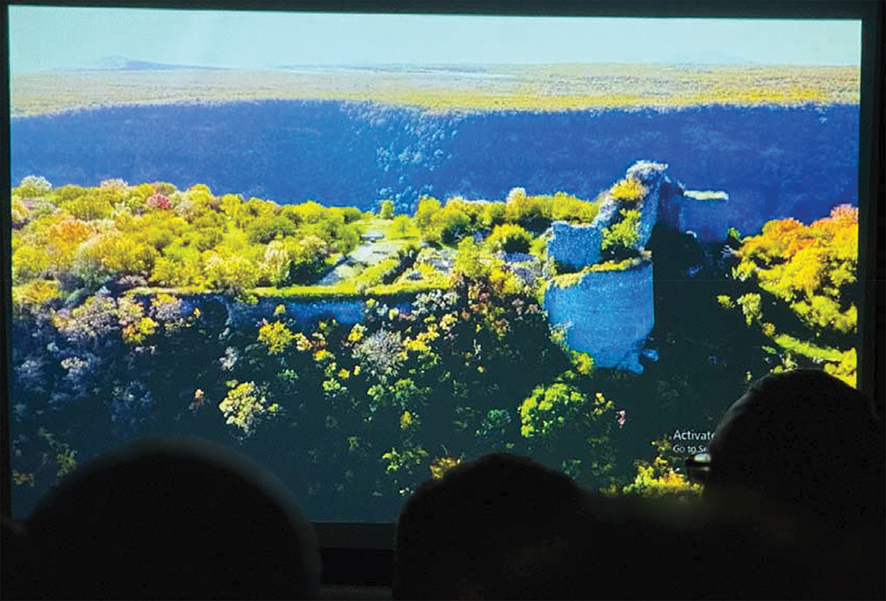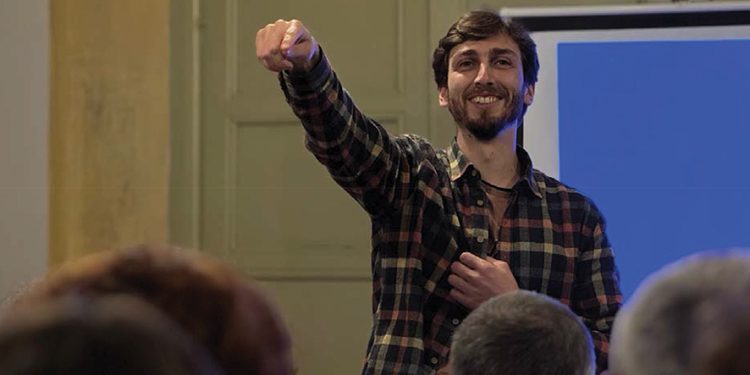On the evening of November 15, the National Trust of Georgia transformed its office into a gateway to the ancient world. The screening of a documentary chronicling a decade of research into the Khrami Canyon’s ancient settlements and megalithic structures captivated the audience. Directed by seasoned researcher David Goguadze and featuring young archaeologist Giorgi Burjanadze, the film bridged past and present with a mix of meticulous historical inquiry and cutting-edge technology.
The Khrami Canyon: A Timeless Crossroads
Imagine a canyon where millennia of history converge; a place where ancient civilizations once thrived, leaving behind enigmatic megalithic structures that have puzzled researchers for years. The Khrami Canyon, a hidden jewel of Georgian archaeology, was the central character of the evening.
The documentary opened with sweeping aerial shots, immediately setting a tone of wonder. The rugged landscapes of the canyon seemed alive with stories, their mysteries amplified by the persistent curiosity of those who have explored them.
David Goguadze’s calm and reflective narration paired perfectly with the energetic curiosity of Giorgi Burjanadze, brought a modern lens to ancient questions integrating geoinformation systems (GIS). Together, they unraveled the history of civilizations that called the canyon home, showing how human activity shaped and reshaped this land over thousands of years.
Megaliths and Modernity: Technology as a Time Machine
One of the film’s standout elements was its portrayal of technology as a key to unlocking ancient secrets. Using GIS, lidar, and other advanced tools, the research team revealed pathways, settlements, and structures buried beneath centuries of erosion and vegetation.
In one particularly striking sequence, lidar scans exposed a hidden network of ancient roads that suggested trade routes and migrations. Visual reconstructions added another layer of depth, turning cold data into living, breathing history. These moments weren’t just informative; they were transformative, allowing the audience to witness the past coming back to life.

The Stories Stones Tell
The megalithic structures of Khrami Canyon are more than remnants of an ancient world; they are symbols of resilience and transformation. The documentary delved into their possible functions, from places of worship to fortifications, while also exploring their spiritual and cultural significance.
Goguadze and Burjanadze emphasized the importance of viewing these sites not in isolation but as part of a broader narrative. The canyon was a crossroads of civilizations; a place where cultures met, exchanged ideas, and sometimes clashed. These stories were etched into the stones, waiting for modern explorers to interpret them.
An Intergenerational Exploration
At the heart of the film was a compelling partnership between two researchers from different generations. Goguadze’s decades of experience and Burjanadze’s innovative approach symbolized the evolution of archaeology itself; a field increasingly defined by collaboration and interdisciplinary methods.
Their dynamic interaction was not just inspiring, but also instructive, demonstrating how experience and innovation can coexist to create a fuller understanding of the past.
A Local Event with Global Resonance
The choice to screen the film in the National Trust of Georgia’s office added an intimate, conversational tone to the event. The free entrance drew a diverse audience, and the inclusion of English subtitles ensured accessibility for international viewers.
This accessibility was crucial, as the documentary is as much a celebration of Georgian heritage as it is a call to global audiences to appreciate and protect the country’s archaeological treasures. The post-screening discussion added another layer of depth, allowing attendees to engage directly with the filmmakers.
The documentary was more than a recounting of historical discoveries; it was a reminder of the vital role history plays in shaping our present and future. By combining science, storytelling, and cultural reflection, Goguadze and Burjanadze highlighted the interconnectedness of human civilization.
By Ivan Nechaev














